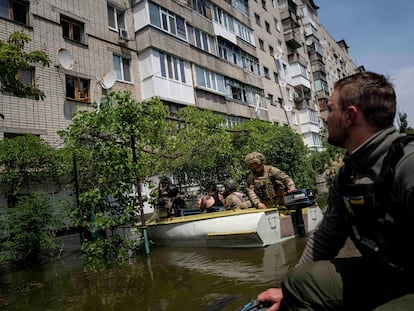After lying underwater for decades, World War II bombs emerge in Ukraine’s Dnipro River
The receding waterline following the June destruction of the Nova Kakhovka dam brings to light dozens of artifacts

Covered with rust and freshwater mollusks, it rests on the sandy shore of the Dnipro River, rocked by a slight swell. At first glance, it does not look like a FAP-50 bomb from a World War II German aircraft, explains Ruslan Anikalov, head of the bomb squad in the city of Zaporizhzhia (southern Ukraine), who came to remove it. “There is no doubt,” he asserts after confirming what the ordnance is. To move it, they use a military canvas stretcher like the ones used to carry the wounded from the war front. The two men carrying the device, which weighs around 40 kilos (88 pounds), have to make a stop on their way to the truck into which they are loading it. On the same beach, a hundred meters away, a family is keeping an eye on their fishing rod. A little inland, a group of people wait for the charcoal flame to die down before starting to put meat on the barbecue.
The destruction on June 6 of the Nova Kakhovka dam, some 200 kilometers (124 miles) downstream from the town of Zaporizhzhia, not only took the lives of several dozen people. In the Ukrainian-controlled area alone, the death toll rose to 29, Interior Minister Igor Klimenko announced on Thursday. The destruction of this infrastructure also lowered the water level to such an extent that dozens of bombs like this FAP-50 have emerged after remaining underwater since the 1939-1945 conflict. Over the past few weeks, security forces in Zaporizhzhia have received “an average of two or three calls every day from citizens who come across such weaponry while taking walks or fishing on the shore,” Anikalov explains. The instruction, he adds, is not to touch them because they are potentially dangerous, although he admits that it is difficult for them to explode without being manhandled. In fact, the fate of all of them is to be detonated and destroyed.
“After World War II, those unexploded bombs sat underwater. Just think, 1943 and 1944, without the necessary equipment to locate them, divers and such... when everything was destroyed,” says historian Svitlana Volodimorivna, an employee of the Zaporizhzhia Regional Museum. “It’s a problem that has remained submerged all these years,” she concludes. Volodimorivna explains that the Germans tried to benefit from the large hydroelectric plant, as well as the metallurgical factories in Zaporizhzhia, and that is why they did not bombard the city at first. “But in their retreat, in 1943, they destroyed everything at once. At that time it was normal in our ranks as well as in the German ranks to fire artillery or bombard from the air with shells that fell, but did not explode,” she adds.
About 20 kilometers (12 miles) from Zaporizhzhia, in another point of the river where another bomb was found, human bones have also recently emerged. The emergency services — which showed the photos to EL PAÍS — do not know if they belong to soldiers of the Soviet or Nazi army who fought in the area. It is easy to see the effects of low water in the area. The river has a kind of new beach on its way through the city, which has become an attraction for the local residents. It is not a very pleasant place because instead of sand, the terrain is made of mud and large drainage pipes are visible. Next to them lies a young boy’s library card that expired a decade ago.
“I have never seen the river in such a terrible state,” laments Grigori Markov, 76, as he and his grandson survey the area. “I see this that our “brothers” [referring to the Russians] have done and I have to feel offended, insulted and hurt. People used to come here to relax, to fish, and look at what it’s become, the rocks sticking up there, impeding navigability,” he says as he turns to view the full panorama, contemplating the large portion of land sticking up in the air.
As part of that battle that Zaporizhzhia experienced during World War II, local troops, in an action similar to that of Nova Kakhovka, blew up the large dam built on the Dnipro. Tens of thousands of people, up to 100,000 according to some sources, died in the operation carried out on August 18, 1941. According to Svitlana Volodimorivna, “everything was flooded, including some of the ammunition. Many shells were submerged after the detonation of the DniproHES,” as the hydroelectric power station, the largest in Ukraine and one of the largest in Europe, is known today.
It was Josef Stalin who called on his secret agents of the NKDV — later the KGB — to blow up the dam to stop the Nazi advance. “There was an order from Stalin to destroy everything, as he himself wrote then, whether they were bread barns or factories. Everything had to be destroyed. Such was the policy of a mentally ill man like him. There is a lot of evidence of this in Russian history for which no human explanation can be found,” says the expert.
The recent destruction of Nova Kakhovka was not as lethal as that of 82 years ago. But it is similar in that this one has also dangerously moved the explosives in minefields in an area where the Dnipro separates the positions of the two armies. In fact, the facilities of the Nova Kakhovka dam and hydroelectric station were in the hands of the invading troops and the available data suggests that the destruction was caused by explosives placed by the Russians.
At the headquarters of the Zaporizhzhia Regional Museum they are not interested in the fate of the finds that war archeology is bringing to light these days by the receding waters of the Dnipro. They are more concerned about their permanent collection. In fact, a large proportion of the pieces have not been on display for months, as they were removed and transported to safe places for fear that the Russians would occupy the city, explains Irina Anatolivna, an employee of the exhibition.
It would not be the first time that invaders have attacked museums and galleries or simply destroyed them. By the end of 2022, more than 1,100 elements of Ukraine’s cultural heritage (architecture, museums, schools, universities, and cultural centers) had been damaged and more than 400 destroyed, according to the Ministry of Culture. In Kherson, the result of the occupation was, among many other tragedies, the plundering of the two major museums of this southern city, which the local army liberated last November.
However, Irina Anatolivna unlocks a room that shows the history of Ukraine from its independence from the USSR in 1991 until today, almost literally. It is surprising to see a space that is bustling with so much life, as only a few weeks ago the museum installed part of an S-300 missile that was launched by the Russians only last May over the town of Vilniansk, just outside the regional capital. “The kids are amused because it looks like a washing machine to them,” the museum worker notes.
Also on display are tributes to the fallen during the present Russian invasion and during the Maidan revolution in 2014, weapons interspersed with paintings by local artists. On the ground a few meters away lie the remains of an Iranian-made drone launched on February 10 against the DniproHES hydroelectric facilities. “Look at that cynicism,” Anatolivna points to the message the Russians left written in black marker next to one of the device’s wings: “Let’s turn on the lights.”
Sign up for our weekly newsletter to get more English-language news coverage from EL PAÍS USA Edition
Tu suscripción se está usando en otro dispositivo
¿Quieres añadir otro usuario a tu suscripción?
Si continúas leyendo en este dispositivo, no se podrá leer en el otro.
FlechaTu suscripción se está usando en otro dispositivo y solo puedes acceder a EL PAÍS desde un dispositivo a la vez.
Si quieres compartir tu cuenta, cambia tu suscripción a la modalidad Premium, así podrás añadir otro usuario. Cada uno accederá con su propia cuenta de email, lo que os permitirá personalizar vuestra experiencia en EL PAÍS.
¿Tienes una suscripción de empresa? Accede aquí para contratar más cuentas.
En el caso de no saber quién está usando tu cuenta, te recomendamos cambiar tu contraseña aquí.
Si decides continuar compartiendo tu cuenta, este mensaje se mostrará en tu dispositivo y en el de la otra persona que está usando tu cuenta de forma indefinida, afectando a tu experiencia de lectura. Puedes consultar aquí los términos y condiciones de la suscripción digital.
More information
Archived In
Últimas noticias
Most viewed
- Reinhard Genzel, Nobel laureate in physics: ‘One-minute videos will never give you the truth’
- Oona Chaplin: ‘I told James Cameron that I was living in a treehouse and starting a permaculture project with a friend’
- Pablo Escobar’s hippos: A serious environmental problem, 40 years on
- Why we lost the habit of sleeping in two segments and how that changed our sense of time
- Charles Dubouloz, mountaineering star, retires at 36 with a farewell tour inspired by Walter Bonatti









































